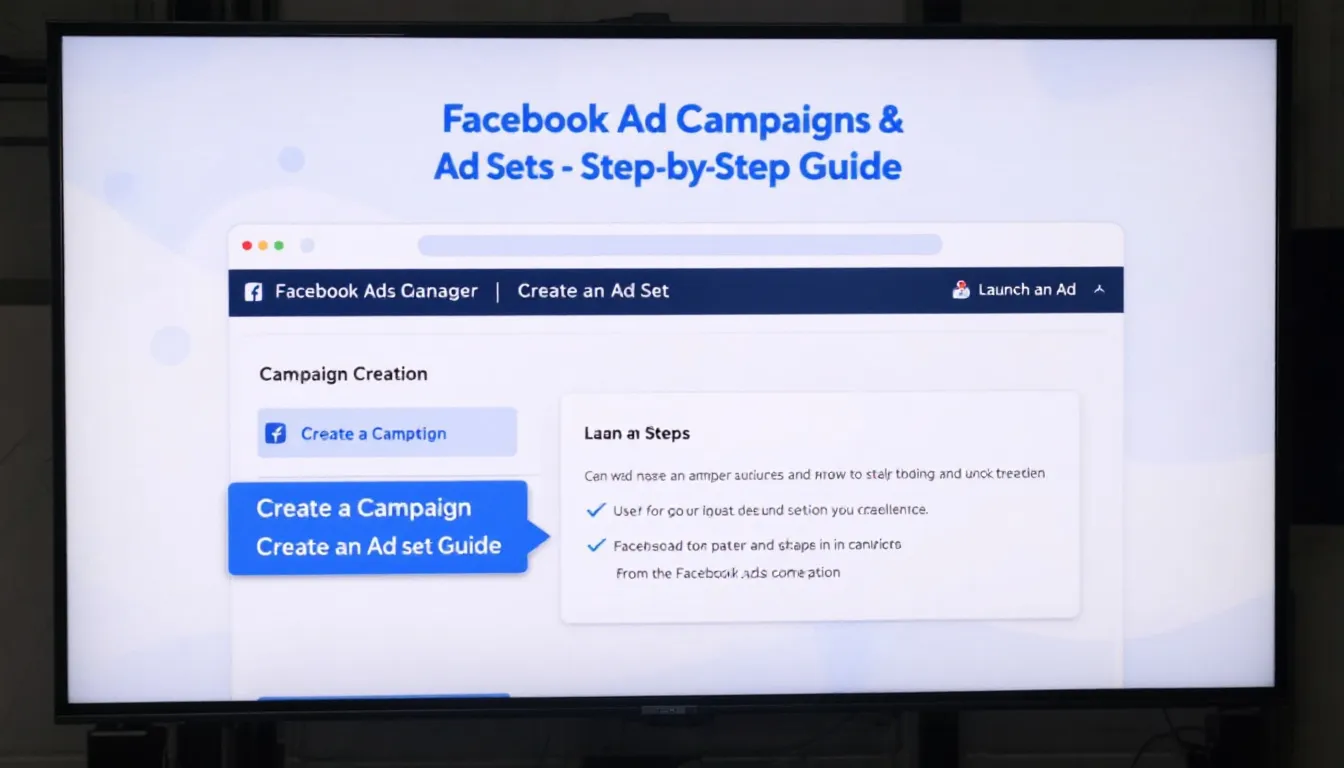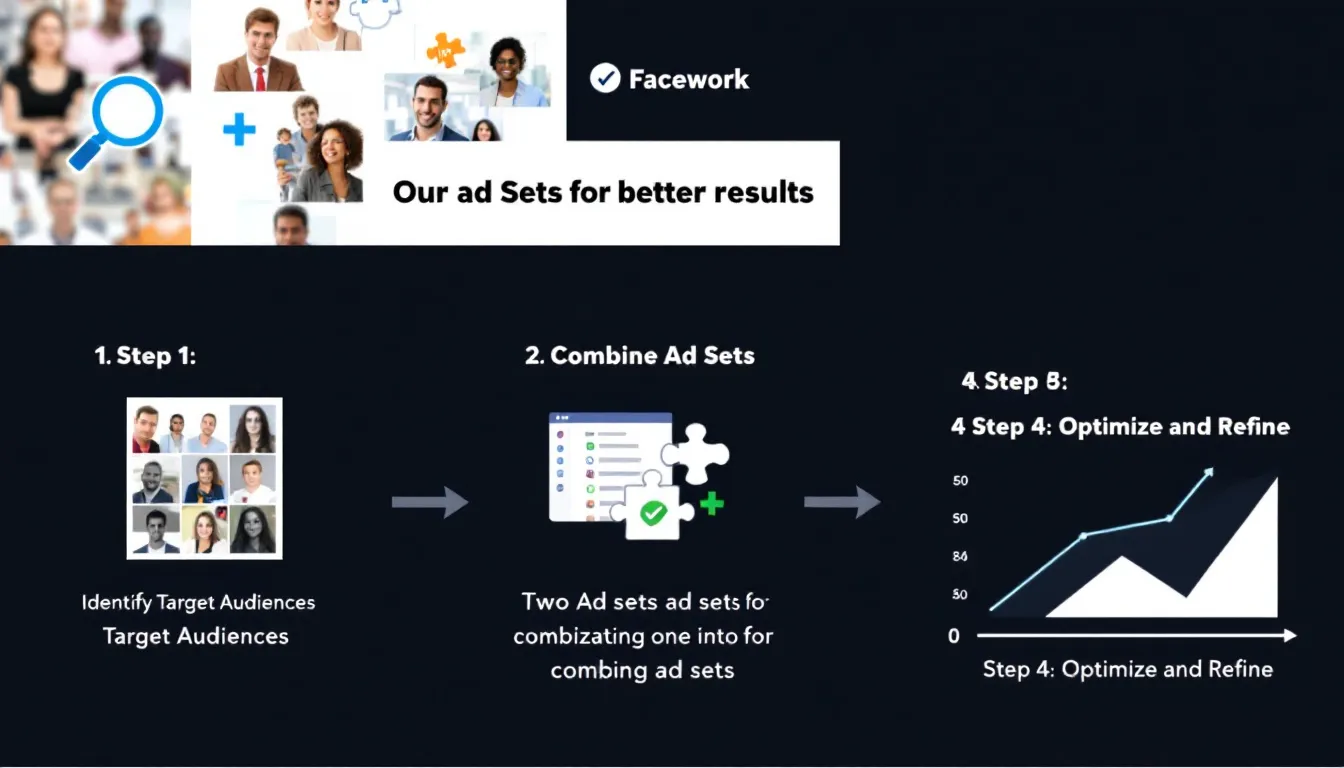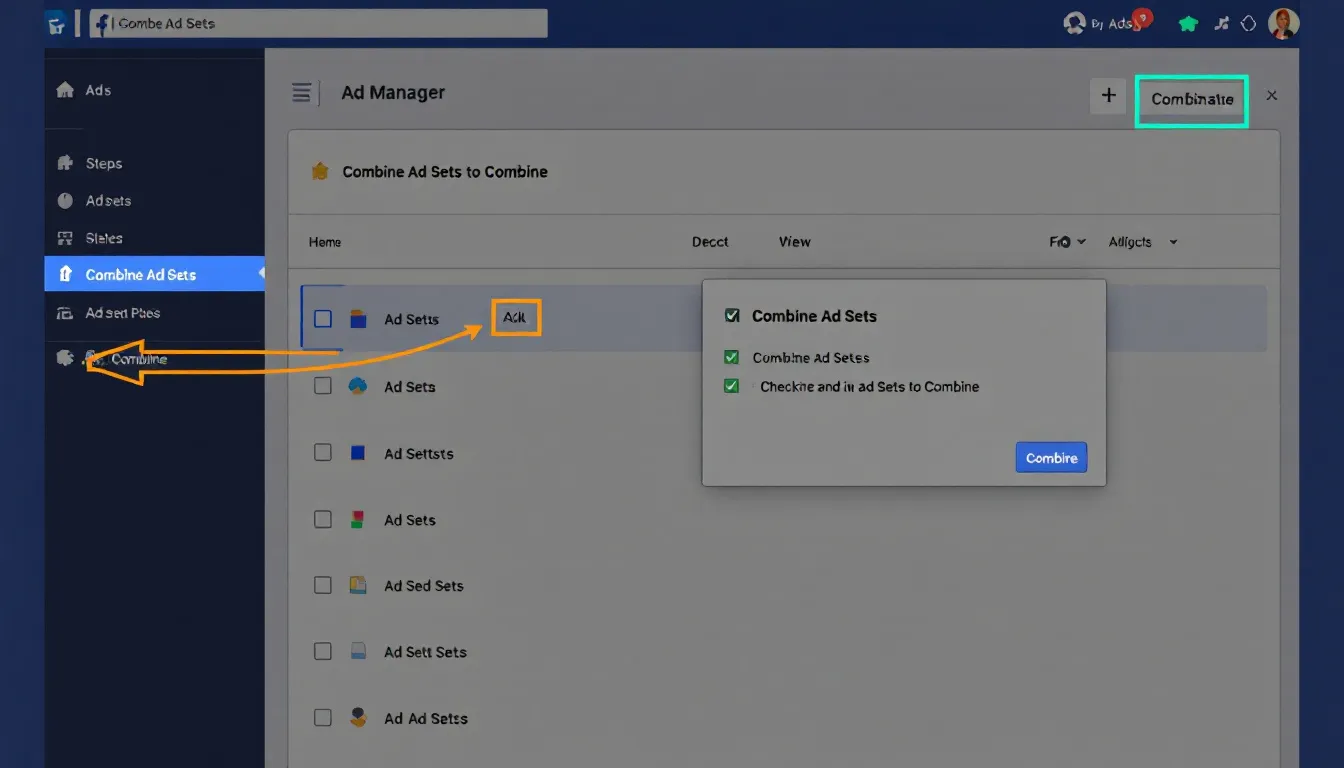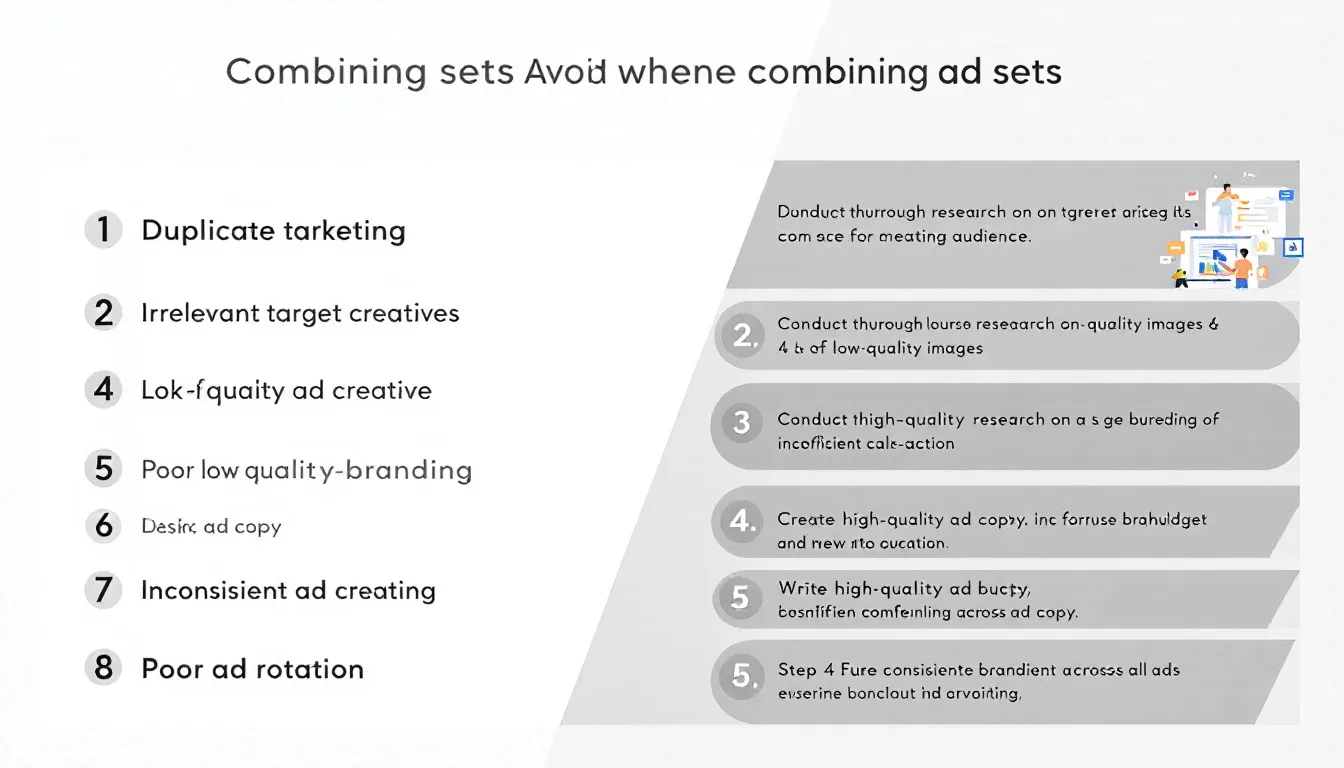ad ad campaigns ads facebook ad sets facebook ad spend facebook ads facebook ads budget instagram ad sets

How To Combine Facebook Ad Sets: A Guide for Top Meta Ad Campaign Performance
If you want to improve your Facebook ad performance, knowing how to combine Facebook Ad Sets effectively is crucial. Merging ad sets can streamline your campaign, optimize your budget, and help you reach a larger audience. This guide will walk you through the steps needed to combine ad sets successfully.
Key Takeaways
-
Understanding the structure of Facebook ad campaigns is essential for effective advertising, where campaigns consist of ad sets targeting specific goals.
-
Combining ad sets can enhance ad performance by optimizing budgets, preventing audience fragmentation, and leveraging aggregated data for informed decision-making.
-
To effectively combine ad sets, it is crucial to assess performance, merge similar target audiences, consolidate budgets and creative assets, while avoiding common pitfalls such as underfunding and audience overlap.
Understanding Facebook Ad Campaigns and Ad Sets

Mastering Facebook advertising starts with understanding the foundational structure of Facebook ad campaigns. A Facebook ad campaign is essentially a collection of multiple ad sets and ads that target a single goal, such as lead generation or brand awareness. Each campaign is designed with a specific objective, guiding strategy and aligning efforts to achieve the desired outcome.
Facebook’s advertising activity is structured into three tiers: ads, campaigns, and ad sets. At the facebook campaign level, advertisers set the overarching objective, such as increasing website traffic or driving app installs. This decision shapes the campaign’s direction and serves as the foundation for all subsequent actions, influenced by facebook’s algorithms.
Ad sets, the second tier, play a crucial role in targeting specific audiences. Each ad set allows you to define who you want to reach, enabling tailored multiple ads to be delivered effectively. This level of granularity ensures that your message resonates with the right people, maximizing the impact of your ads. Ad sets also allow for distinct budgets, placements, delivery options, and schedules, providing flexibility and control over your advertising efforts.
Key features determined by an ad set include budget, placement, delivery, audience, and schedule. Careful configuration of these elements optimizes ad performance, ensuring they reach the intended audience at the right time. Grasping the structure of Facebook ad campaigns is vital for forming a better advertising strategy and lays the groundwork for all decisions and actions.
Benefits of Using Multiple Ad Sets
Using multiple ad sets can be beneficial for several reasons. Firstly, it allows you to target different segments of your audience with separate ad sets, which can help to increase the relevance and effectiveness of your ads. For instance, if you’re selling a product that appeals to both men and women, you can create separate ad sets for each gender to target them with ads that are tailored to their specific interests and needs.
Secondly, using multiple ad sets can help to reduce auction overlap, which occurs when multiple ad sets compete for the same audience. By separating your ad sets, you can reduce the competition for ad space, increasing the chances of your ads being seen by your target audience. This strategy ensures that your ads are delivered more efficiently, maximizing their impact.
Finally, using multiple ad sets allows you to test different ad creatives, targeting options, and bidding strategies. This flexibility enables you to identify what works best for your audience and optimize your ad campaigns for better performance. By experimenting with various ads and strategies, you can gather valuable data that informs your future advertising efforts, leading to continuous improvement and success.
Benefits of Combining Ad Sets

Combining ad sets can transform your advertising strategy, bringing a host of benefits that can enhance performance efficiency and streamline your efforts. Merging multiple ad sets allows advertisers to pool data into larger segments, leading to better optimization and informed decision-making. This approach not only simplifies campaign management but also leverages the power of aggregated data to drive superior results. Facebook’s algorithms play a crucial role in this process by improving ad performance through effective budget allocation and data consolidation.
One of the primary advantages of combining ad sets is the ability to optimize your budget across different ad sets. Consolidating budgets ensures more effective resource allocation, reducing time and money spent during the initial learning phase of Facebook ads. This streamlined approach can lead to better overall performance, as your ads benefit from more efficient budget utilization.
Another significant benefit of combining ad sets is the prevention of audience fragmentation. When ad sets with similar creative are kept separate, there’s a risk of diluting your audience, leading to less impactful campaigns. Merging these ad sets helps you reach a larger audience within a single ad set, increasing the likelihood of achieving your campaign objectives.
The advice to consolidate ad sets has become increasingly relevant due to changes in targeting dynamics. As Meta Platforms, Inc. suggests, combining ad sets can enhance overall performance by adapting to these evolving dynamics. This strategy helps advertisers stay ahead of the curve and maintain campaign effectiveness in a constantly changing environment.
Optimizing Ad Set Structure for Better Performance
Optimizing ad set structure is crucial for achieving better performance in Facebook ad campaigns. One effective strategy is to combine multiple ad sets into a single ad set. This approach leverages Meta’s advanced targeting and learning algorithms more effectively, leading to improved results in your Facebook advertising efforts. By consolidating ad sets, you can streamline your campaign management and ensure that your budget is utilized more efficiently.
Additionally, it’s important to optimize the number of ads per ad set. While it might be tempting to include a large number of ads to cover all bases, this can actually lead to decreased performance and wasted budget. Instead, focus on a few high-quality ads that are tailored to your target audience. This ensures that each ad receives sufficient exposure and allows Facebook’s algorithms to learn and optimize more effectively.
By carefully structuring your ad sets and optimizing the number of ads within each set, you can enhance the efficiency and performance of your Facebook ad campaigns, ultimately driving better results.
Steps to Combine Ad Sets on Facebook

Combining ad sets on Facebook involves several key steps. Start by accessing Facebook Ads Manager to manage all aspects of your ad campaigns. Using Facebook’s analytics tools, assess the performance of each ad set by focusing on metrics such as engagement and conversion rates. This analysis identifies which ad sets are performing well and which ones may benefit from consolidation.
Next, identify similar or overlapping target audiences across the selected ad sets. Merging ad sets with auction overlap ensures a wider reach and better-targeted ads. This step maximizes the effectiveness of your audience targeting efforts and prevents audience fragmentation.
After identifying the ad sets to combine, merge their budgets into a consolidated amount. This optimizes spending and improves campaign performance, ensuring efficient resource allocation. Consolidating budgets reduces competition among ad sets and enhances overall ad performance.
Next, merge the creative assets of the ad sets. This involves combining the ad creatives, such as images, videos, and ad copies, to create a cohesive and compelling message. Consolidating creative assets enhances the overall efficiency and effectiveness of your campaign.
Finally, closely monitor the performance of the combined ad sets. Use Facebook’s analytics tools to track key performance metrics and make adjustments as needed. Ongoing optimization ensures that your combined ad sets deliver optimal results.
Consolidate Budget and Creative Assets
When consolidating budgets and creative assets, start by choosing between daily or lifetime budget options in Facebook Ads Manager. Daily budgets allow for consistent spending, while lifetime budgets provide flexibility over the campaign’s duration. Select the option that best aligns with your campaign objectives and resource allocation strategy.
Merging budgets of ad sets allows advertisers to optimize resource allocation and improve ad performance. Combining budgets reduces competition among ad sets, leading to better overall performance. Effective budget consolidation can streamline your advertising efforts and ensure that your resources are used efficiently.
Merging creative assets is also crucial for campaign success. Combine ad creatives like images, videos, and ad copies to create a unified and compelling message. This approach enhances campaign efficiency and effectiveness, ensuring your ads resonate with the target audience.
Effective budget and creative asset consolidation significantly enhances campaign efficiency and effectiveness. Streamlining these elements creates a more cohesive and impactful advertising strategy. Practical examples and best practices for consolidating budgets and creative assets can help you achieve optimal results.
Consolidating budgets and creative assets is a vital step in optimizing your Facebook ad campaigns. These strategies improve performance, reduce competition among ad sets, and ensure your ads deliver the desired results.
Common Mistakes to Avoid When Combining Ad Sets

Combining ad sets requires avoiding common mistakes that can negatively impact performance. One mistake is underfunding individual ad sets while managing multiple ad sets. This approach can dilute the effectiveness of your campaigns, leading to suboptimal results.
Another error is overly narrowing targeting options by combining several interests and behaviors into a single ad set. While it may seem efficient, this strategy can limit your reach and reduce the effectiveness of your ads. Striking a balance between broad and narrow targeting achieves the best results.
Targeting similar audiences with separate ad sets can lead to campaign dilution. This happens when multiple ad sets compete for the same audience, resulting in wasted budget and skewed performance metrics. By combining these ad sets, you can prevent audience overlap and enhance overall campaign effectiveness.
Combining ad sets can lead to pitfalls that may negatively affect ad performance. Pitfalls include insufficient budget allocation, overly narrow targeting, and audience overlap. Avoid these issues by carefully planning and executing your ad set consolidation strategy.
Being aware of these common mistakes and avoiding them can significantly improve the outcomes of your combined ad sets. Optimizing your approach ensures that your Facebook ad campaigns deliver the desired results.
Putting it All Together: Best Practices for Facebook Ad Campaigns
Putting it all together, here are some best practices for Facebook ad campaigns:
-
Use a single ad set to leverage Meta’s advanced targeting and learning algorithms.
-
Optimize the number of ads per ad set to improve ad efficiency and performance.
-
Use audience targeting to reach specific demographics, interests, and behaviors.
-
Limit auction overlap to reduce waste and improve ad performance.
-
Use Facebook’s algorithms to optimize ad delivery.
-
Monitor key metrics such as CTR, conversion rate, and ROAS to measure and optimize ad performance.
-
Use Facebook’s built-in analytics tools to gain valuable insights into ad performance and refine targeting and ad creative strategies.
By following these best practices, advertisers can create effective Facebook ad campaigns that drive real results and achieve their marketing goals. Embrace these strategies to unlock the full potential of your Facebook advertising efforts and ensure your campaigns are as impactful as possible.
Frequently Asked Questions
What is the primary benefit of combining ad sets?
The primary benefit of combining ad sets is the optimization of budget allocation and overall campaign performance by utilizing larger data segments for improved optimization. This approach streamlines your advertising strategy effectively.
How do I identify which ad sets to combine?
To effectively identify which ad sets to combine, utilize Facebook’s analytics tools to evaluate performance metrics like engagement and conversion rates. Focus on ad sets that share similar or overlapping target audiences for optimal targeting results.
What are the common mistakes to avoid when combining ad sets?
To achieve optimal results when combining ad sets, avoid underfunding individual ad sets, overly narrowing targeting options, and targeting similar audiences separately. These mistakes can significantly dilute your campaign’s effectiveness.
How does consolidating budgets improve campaign performance?
Consolidating budgets enhances campaign performance by optimizing spending and reducing competition among ad sets, which improves overall efficiency and resource utilization. This strategic approach ultimately leads to better results in your campaigns.
What role do creative assets play in combining ad sets?
Creative assets are essential in combining ad sets as they ensure a cohesive and compelling message, which significantly improves the efficiency and effectiveness of the campaign.
Meredith Kallaher helps small business owners Expand Their Reach and Explode Their Sales with
Facebook and Instagram Advertising Strategy and Management.
Learn How Meredith Can Help You Build Your Business and Exceed Your Sales Goals. Book a FREE DISCOVERY CALL Today.
FREE CHEAT SHEET
Download my FREE FB AD 2025 Strategy Cheat Sheet if you are ready to stop dabbling and start winning with Facebook and Instagram in 2025.
I’m Meredith
We create BIG value for business owners by connecting them with their ideal customers and clients using creative, strategic and authentic digital advertisements.